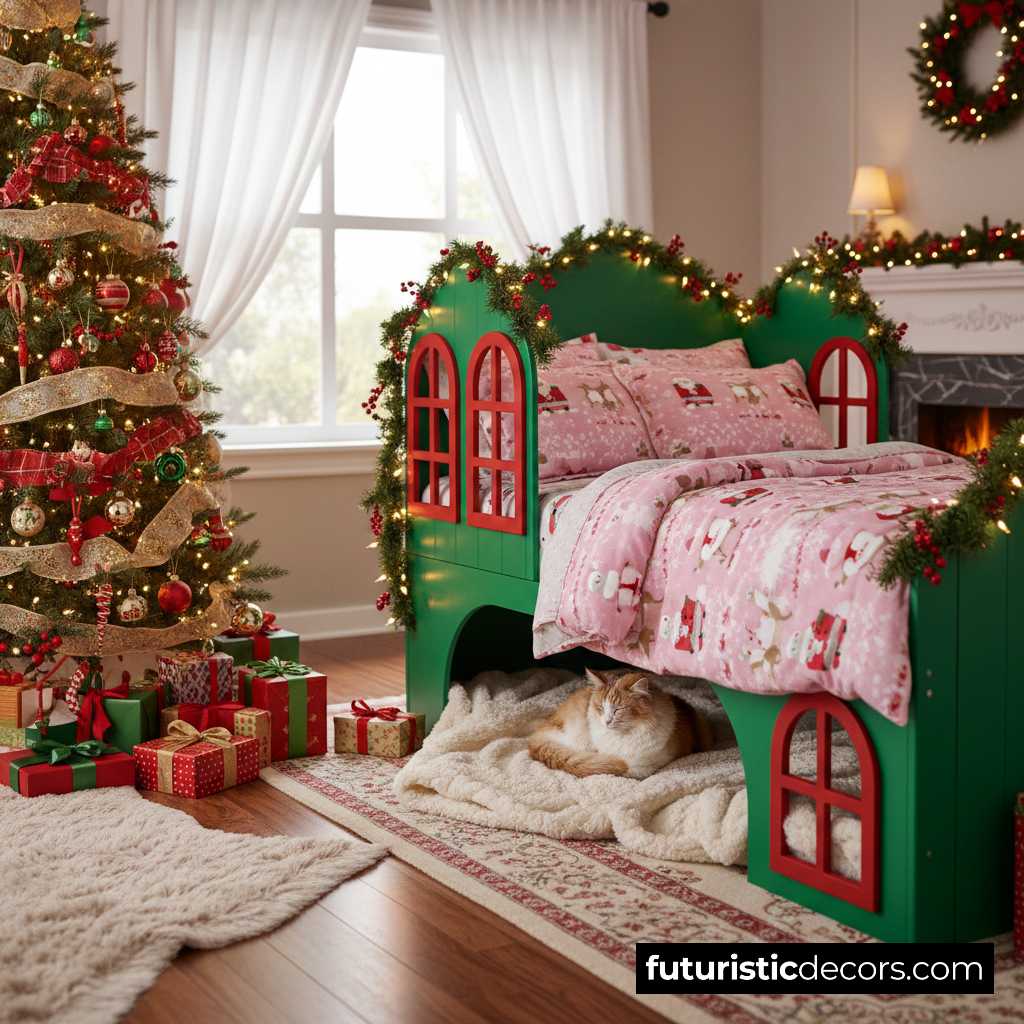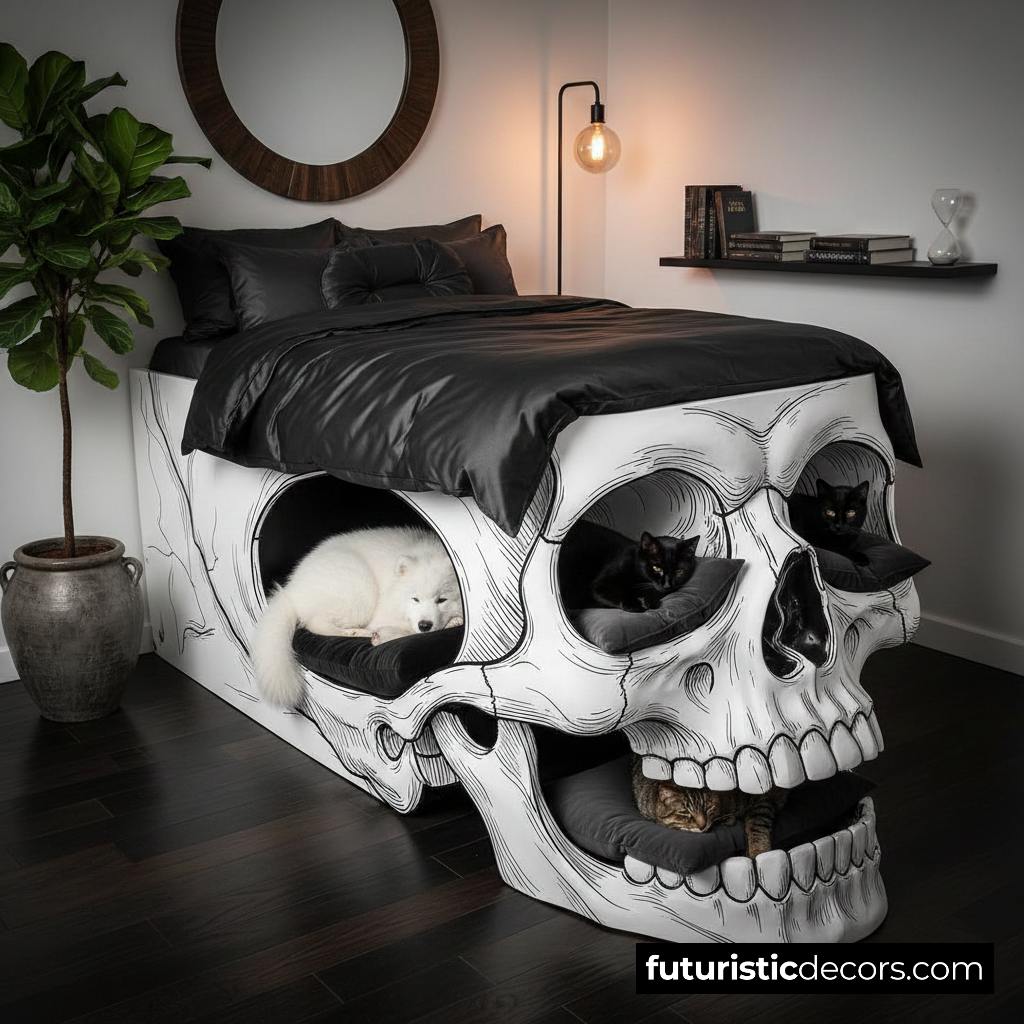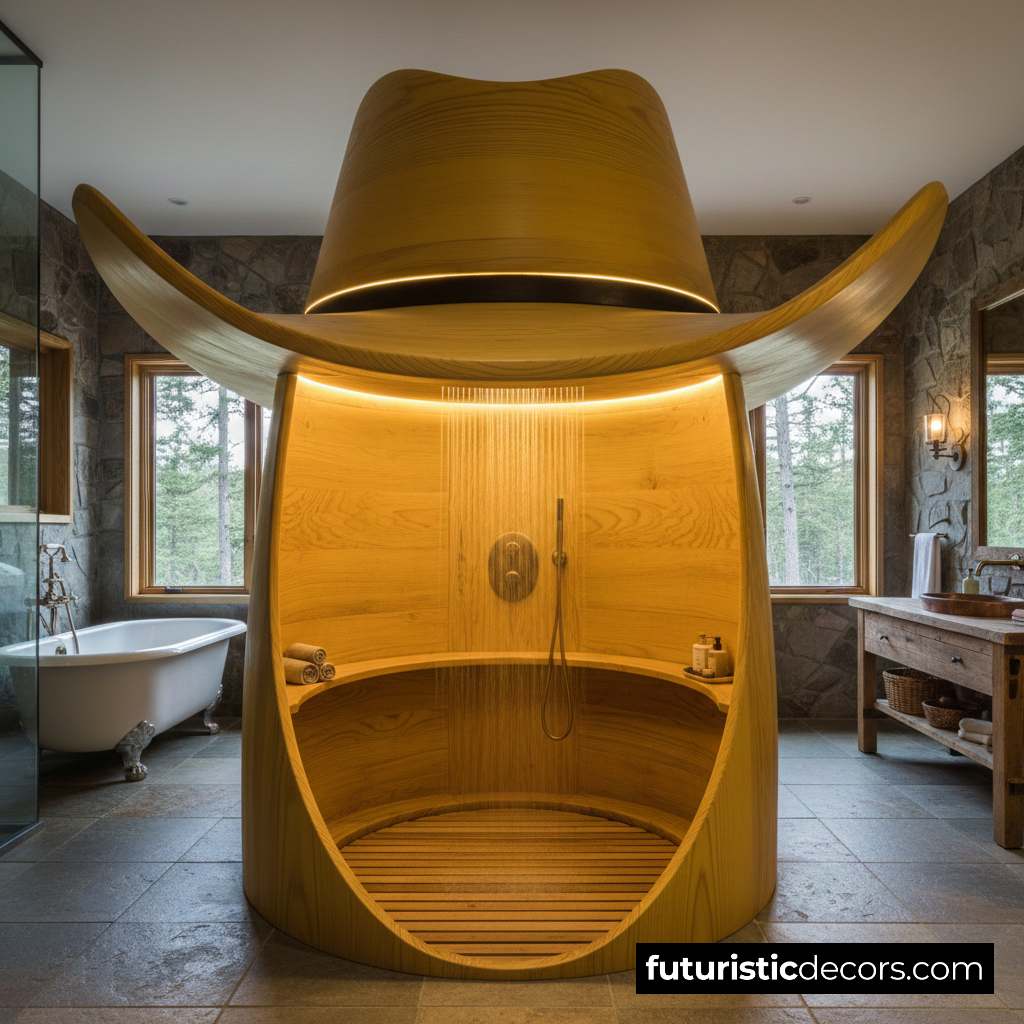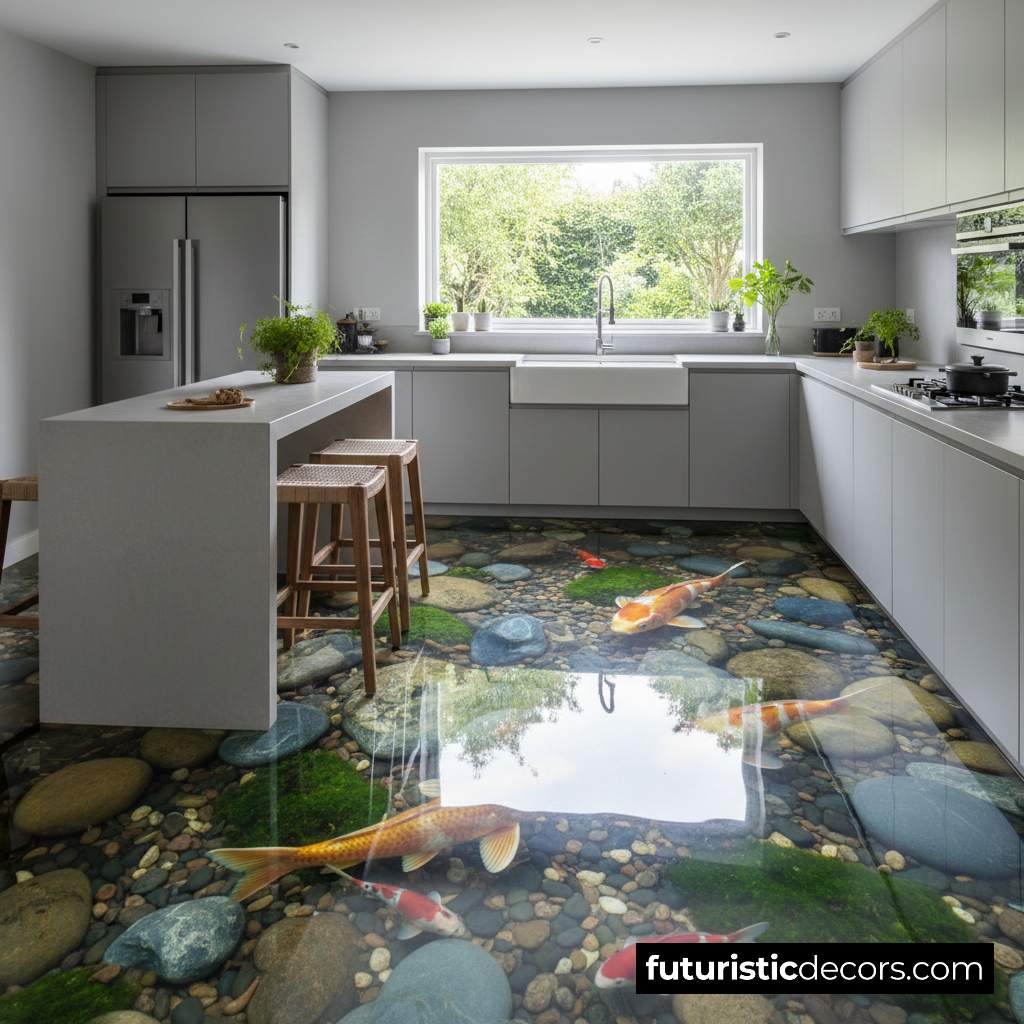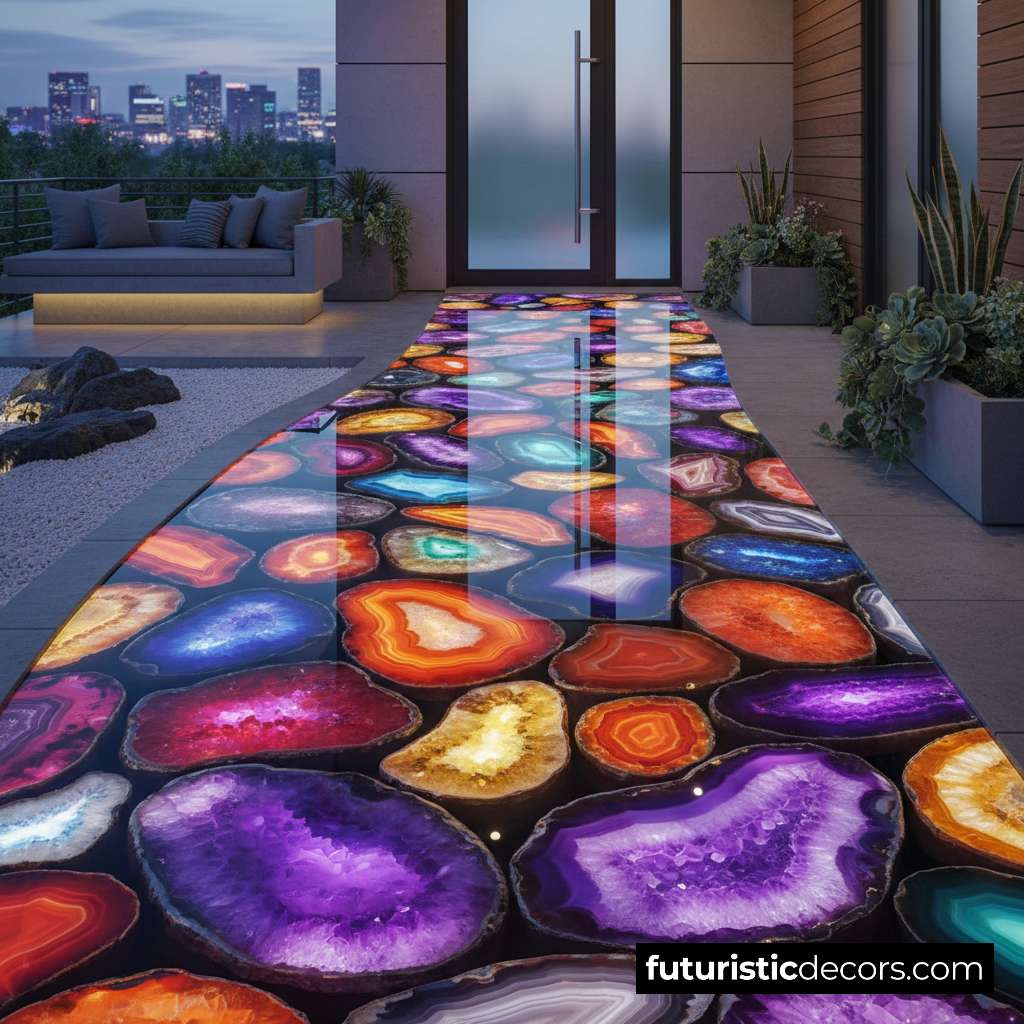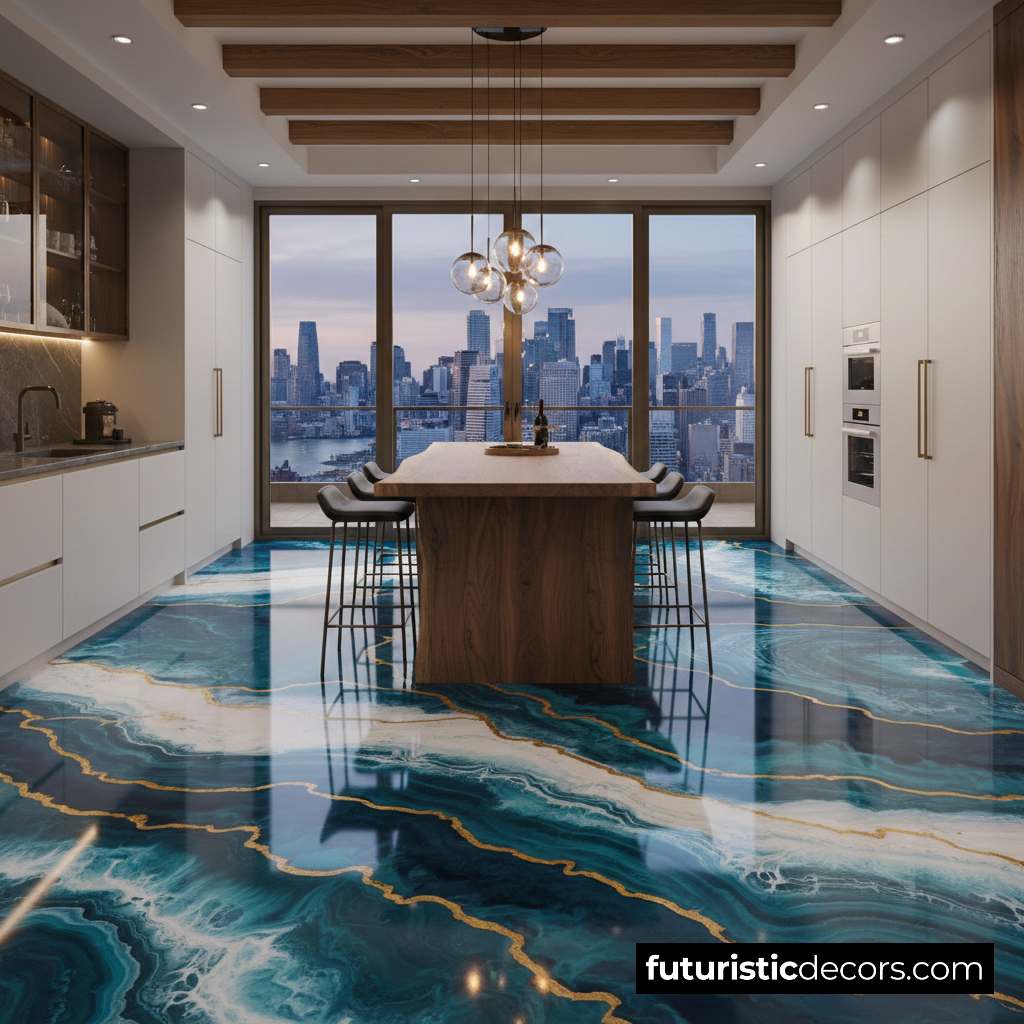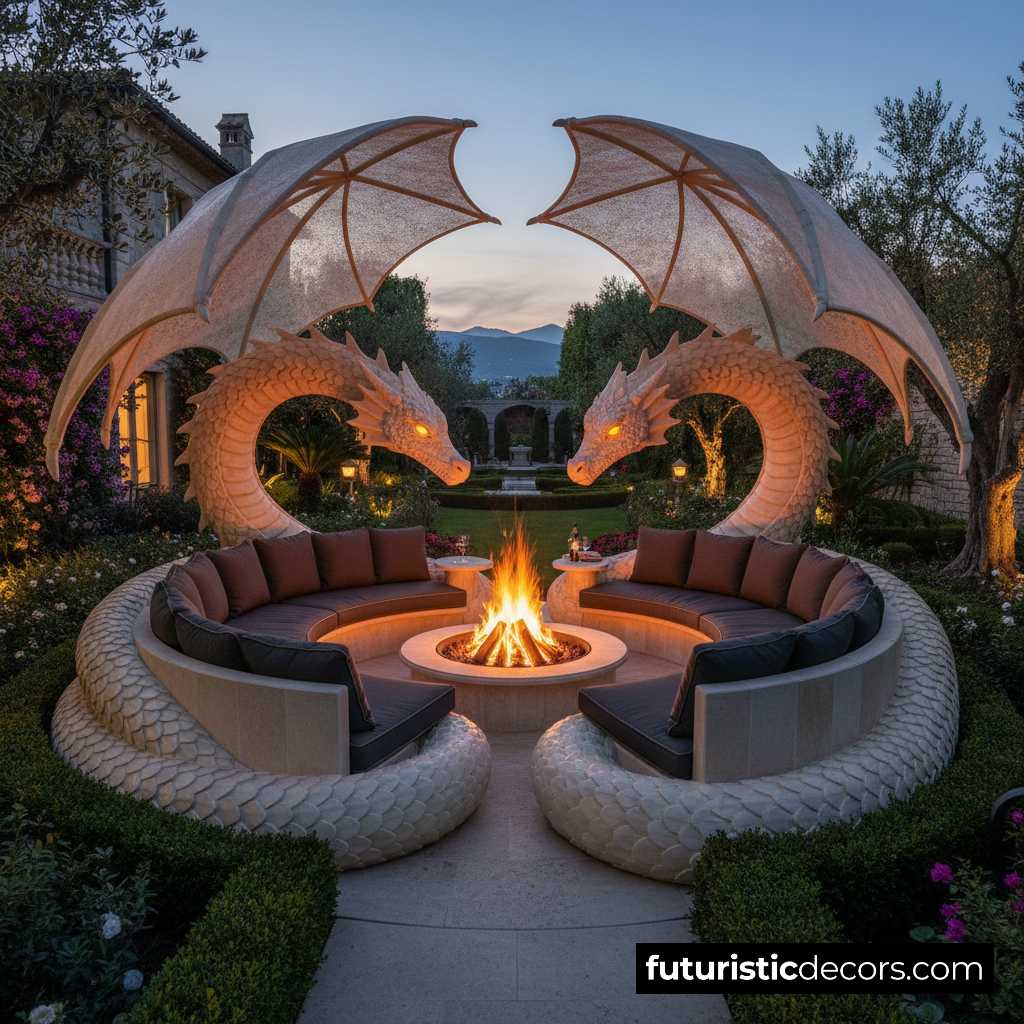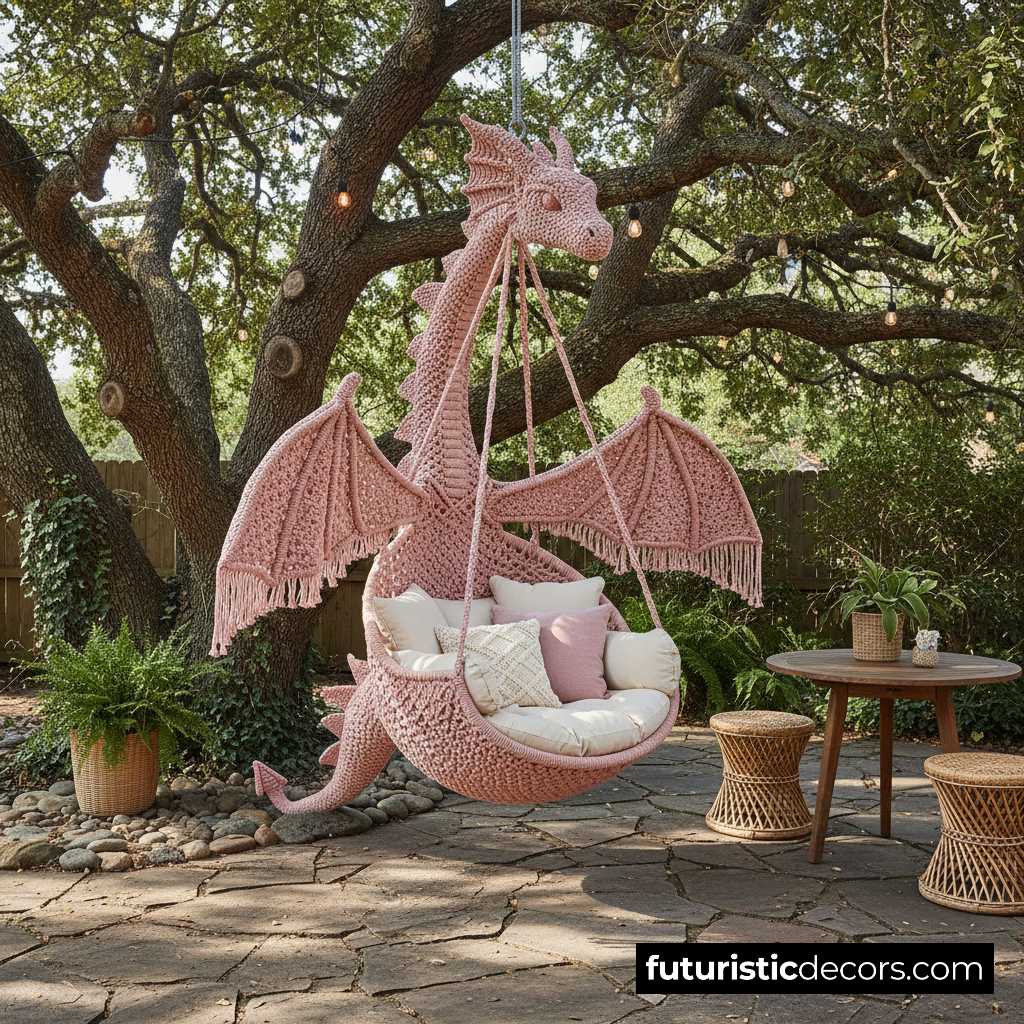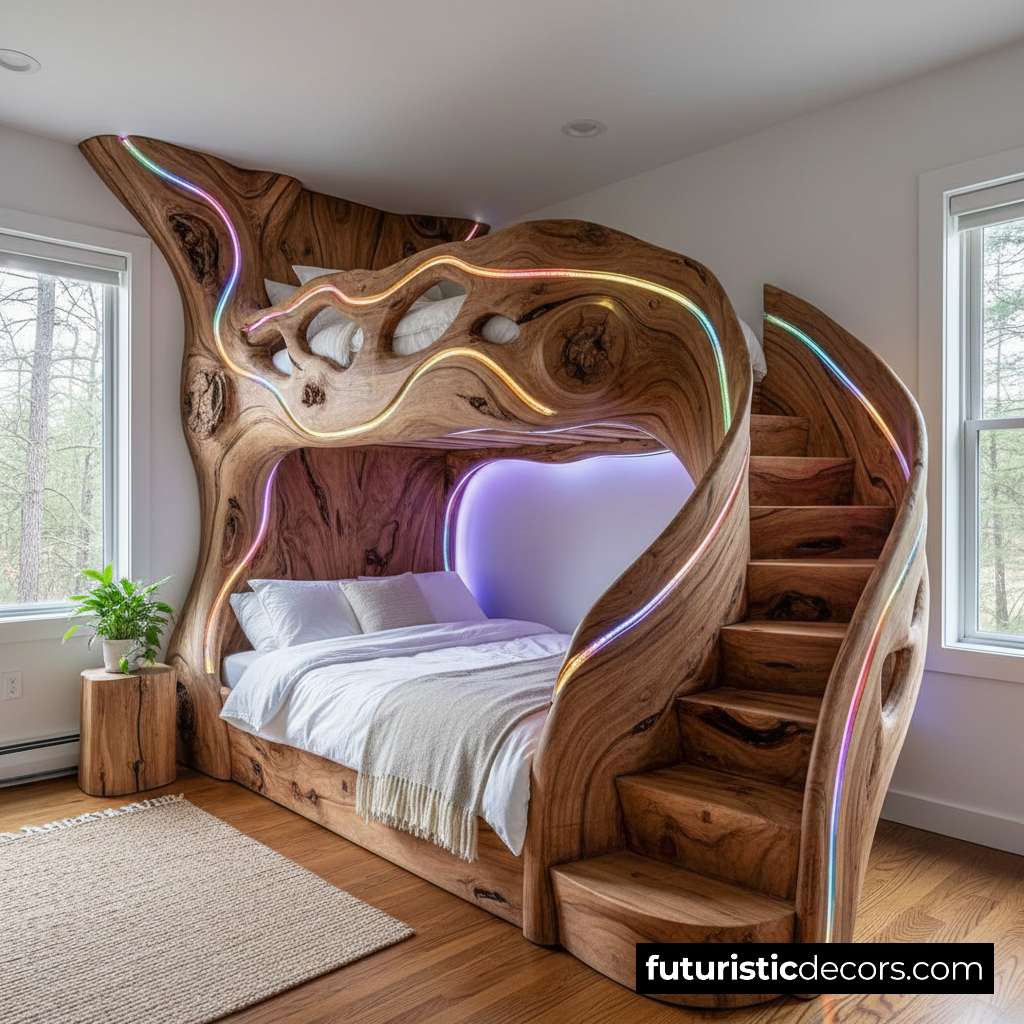Imagine stepping into your bedroom and finding yourself in an enchanted forest, where oversized toadstools glow softly, casting a gentle, otherworldly light. Glowing Mushroom Beds make this dream a reality, blending whimsical design with cutting-edge technology to create a sanctuary that’s as comforting as it is magical. In recent years, these luminous furnishings have captured imaginations—from fantasy enthusiasts to interior designers seeking a statement piece that doubles as functional art.
At their core, Glowing Mushroom Beds are more than just novelty items. They represent a fusion of innovation, craftsmanship, and storytelling, offering users an immersive experience that transforms the bedroom into a fairyland retreat. Whether you’re drawn to bioluminescent-inspired décor, LED-enhanced artistry, or glow-in-the-dark accents, there’s a design to match every taste and space.
In this article, we’ll journey through everything you need to know about Glowing Mushroom Beds: the science behind their ethereal glow, the variety of styles and materials available, DIY versus pre-made options, and expert tips for integrating and maintaining these unique pieces. By the end, you’ll be equipped to select—or even build—your very own fairyland bed, complete with styling advice and practical considerations. Let’s embark on this magical voyage and discover how to transform your bedroom into a luminous haven.
1. The Magical Appeal of Glowing Mushroom Beds
There’s an undeniable allure in surrounding ourselves with elements that evoke wonder. Glowing Mushroom Beds accomplish this by invoking the mystique of bioluminescent fungi found in deep forests and cave ecosystems. In nature, mushrooms like Panellus stipticus and Mycena chlorophos emit a soft, greenish glow to attract insects and aid spore dispersal. Translating this phenomenon into bedroom décor taps into a primal fascination with light and mystery, offering a daily escape into fantasy.
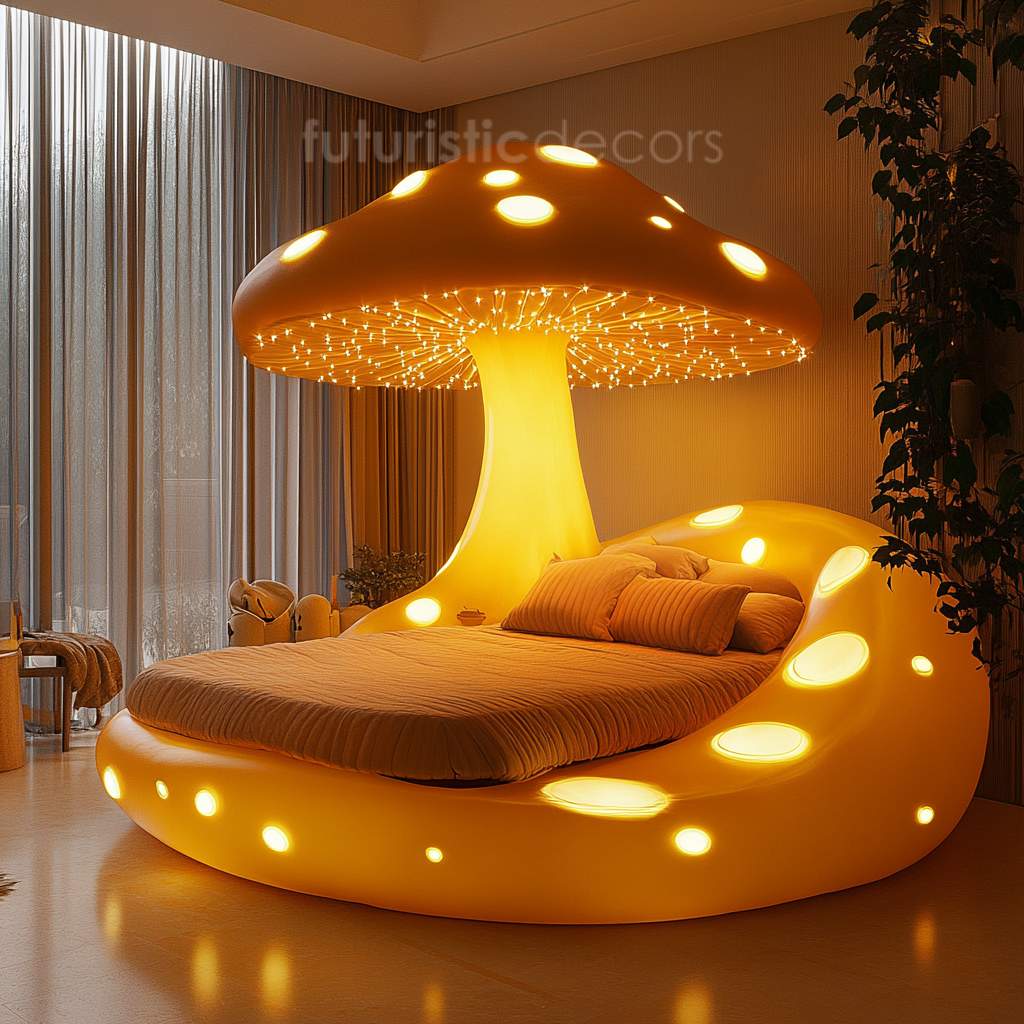
Designers leverage this fascination, crafting bed frames shaped like oversized toadstools, complete with wide caps serving as canopies or headboards. Others opt for minimalistic platforms embedded with glowing inserts—subtle enough for contemporary interiors yet whimsical enough to delight. The result is a focal point that instantly elevates any space, serving both as a conversation starter and a nightly comfort ritual. Parents love them for children’s rooms, while adults use them to carve out a personal retreat that feels both nostalgic and futuristic.
Beyond aesthetics, the soft glow promotes a calming atmosphere, suitable for winding down before sleep or engaging in mindfulness practices. Unlike harsh overhead lighting, the ambient light from a Glowing Mushroom Bed is diffuse, reducing eye strain and fostering relaxation. As the centerpiece of a bedroom design scheme, it invites residents and guests alike to linger, unwind, and indulge in the enchantment of a fairyland retreat.
2. The Science Behind the Glow: Bioluminescence and Technology
To replicate nature’s bioluminescence, designers blend biology-inspired concepts with modern lighting—chiefly LED and fiber-optic systems. True bioluminescent organisms rely on chemical reactions involving luciferin and luciferase enzymes to produce light without heat. While using actual bioluminescent materials indoors remains impractical, engineers mimic the effect through energy-efficient, low-heat LEDs that can be programmed for color shifts, pulsing patterns, and intensity control.
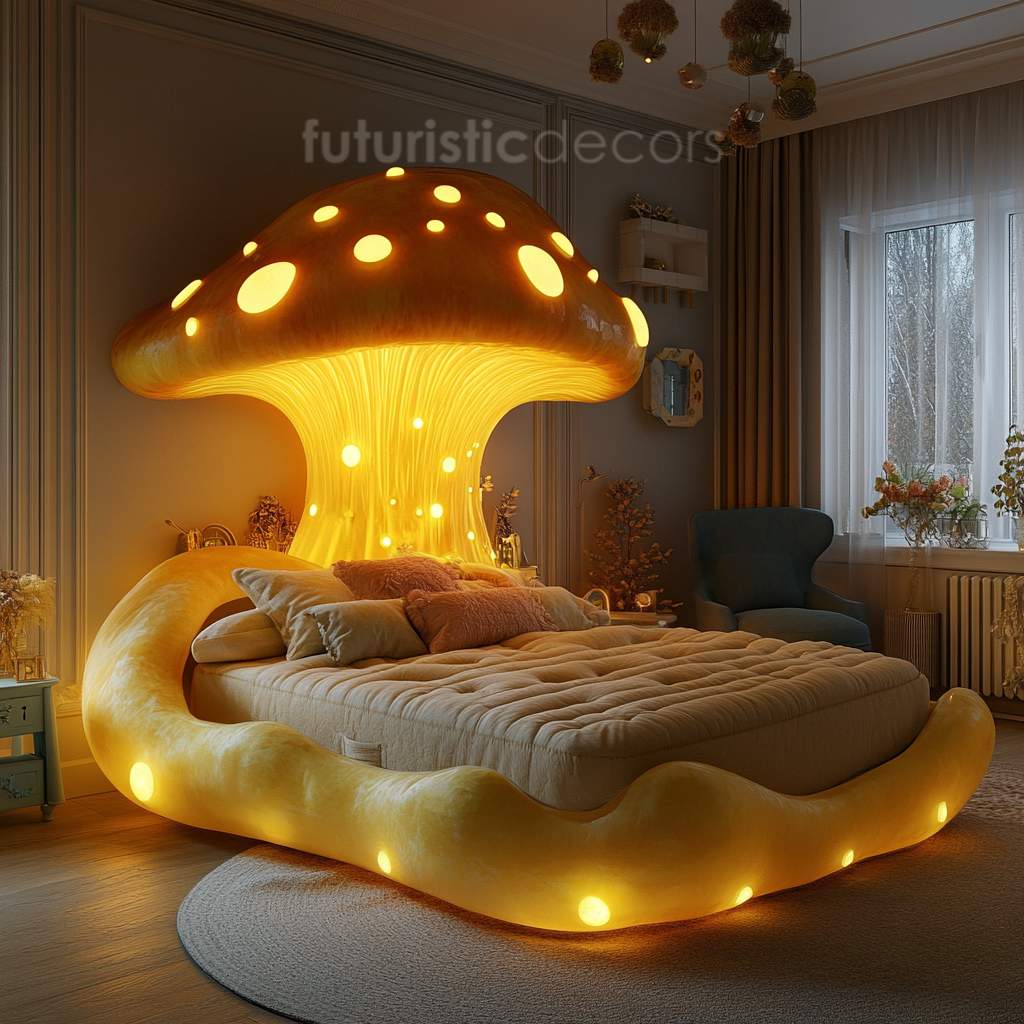
Fiber optics offer another avenue, channeling light through thin strands to illuminate translucent panels or filaments embedded in bed posts and headboards. The light source—typically an LED module—resides out of sight, while the fibers create a uniform, ethereal glow along the edges or surfaces. Glow-in-the-dark pigments, charged by daylight or room light, add supplemental luminosity, though they tend to fade faster and lack color versatility compared to LEDs.
Smart home integration further amplifies the experience. Many Glowing Mushroom Beds now come with Wi-Fi or Bluetooth connectivity, allowing you to sync the glow with your phone, music, or circadian schedules. Imagine your bed glowing in warm hues at sunset, transitioning to cooler tones in the early morning to support your natural wake cycle. Such features not only enhance aesthetics but also contribute to sleep health by minimizing blue-light exposure at night.
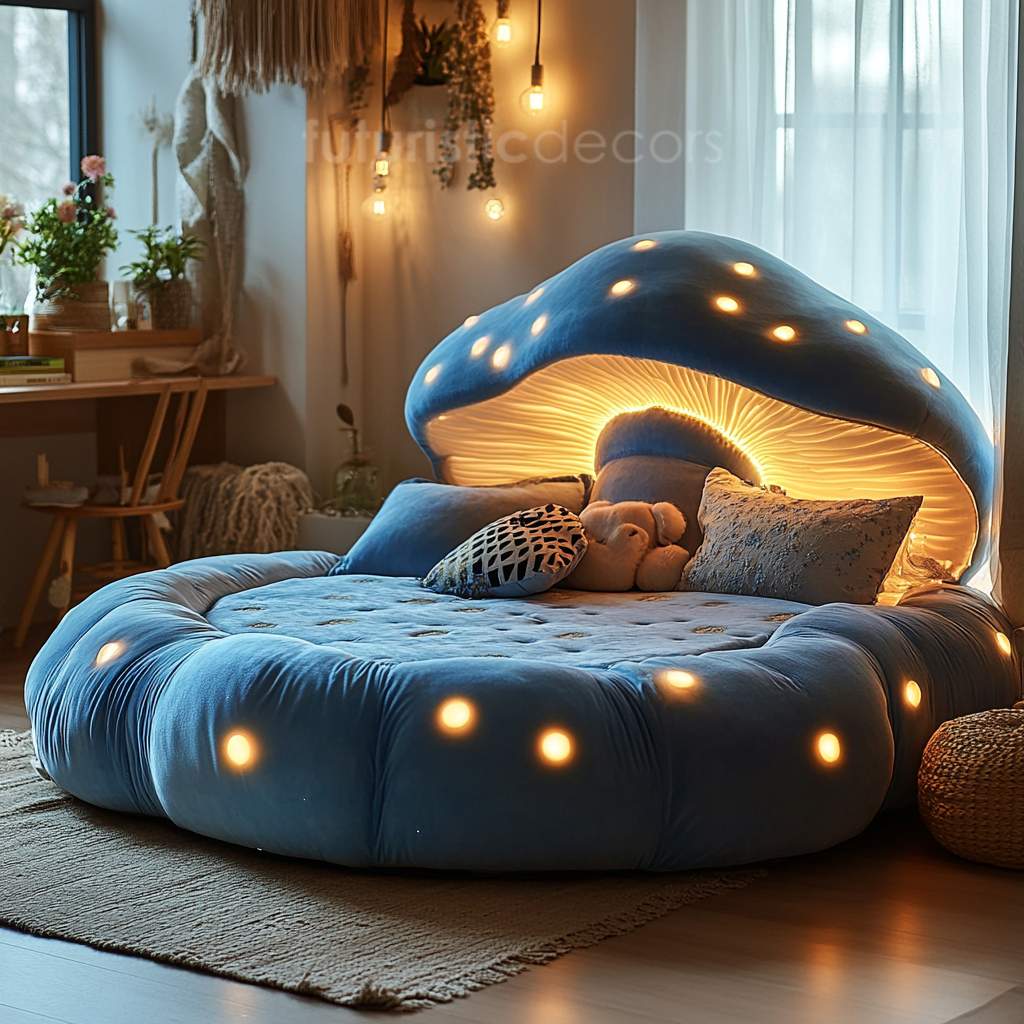
This marriage of biology-inspired wonder and advanced lighting technology ensures that Glowing Mushroom Beds are as functional as they are fantastical, providing an immersive glow without compromising safety, energy efficiency, or user control.
3. Styles and Designs: From Toadstools to Fungi Fractals
Glowing Mushroom Beds come in a spectrum of styles, each catering to different tastes and interior themes. The most iconic design is the oversized toadstool bed, featuring a rounded canopy that mimics the cap of a mushroom. These often pair with stalk-like bedposts, creating a cohesive sculptural piece. Color artists offer variations: classic red-and-white polka dots for a whimsical vibe, pastel pinks and purples for a dreamy feel, or monochrome designs for a minimalist aesthetic.
For those seeking subtler references, platform beds with embedded luminous accents are ideal. Think sleek frames with inlaid light strips tracing organic, fractal patterns reminiscent of fungal mycelium. These patterns not only emit a glow but also cast intricate shadows on walls and ceilings, intensifying the fairyland ambiance. Sculptural headboards cut from laser-etched acrylic panels reveal mushroom silhouettes that glow from within, perfect for modern or industrial-themed rooms.
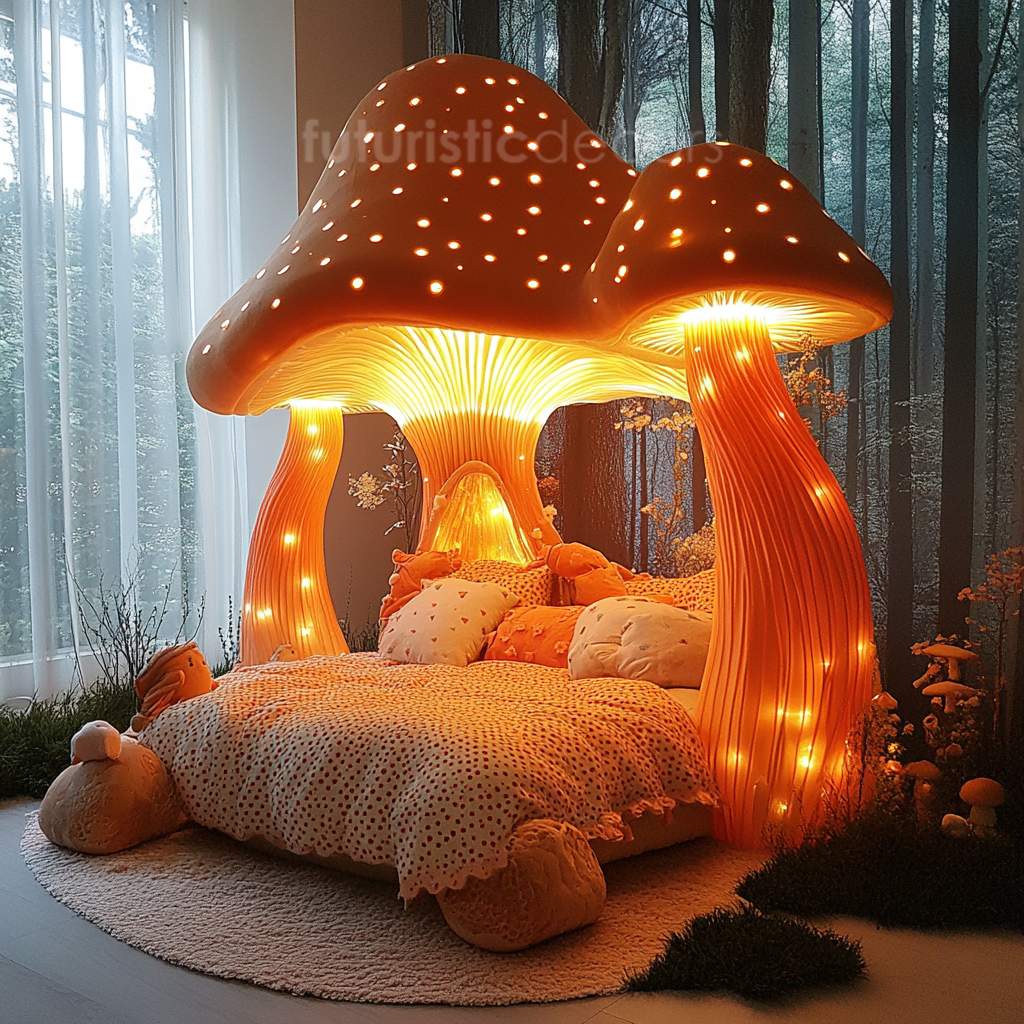
Kids’ versions often double as play forts, with side panels extending down to the floor and integrated storage spaces shaped like mushroom stems. Some models include built-in seating nooks or reading alcoves beneath the cap. For adult spaces, entry-level designs might involve illuminated mushroom-shaped nightstands or bedside stools, allowing homeowners to test the concept before committing to a full-sized bed.
No matter the iteration, the defining characteristic remains consistent: a fusion of organic mushroom shapes and gentle illumination. This ensures that every Glowing Mushroom Bed design serves as both a functional resting place and a sculptural focal point, seamlessly blending form, function, and fairy-tale charm.
4. Materials and Manufacturing: LED vs. Fiber Optic vs. Glow-in-the-Dark
Selecting the right materials is crucial for durability, comfort, and visual impact. Most premium Glowing Mushroom Beds employ powder-coated steel or reinforced plywood for the frame, ensuring strength while allowing for complex shapes. Frames are often insulated or lined with foam to eliminate sharp edges, crucial for curved, organic designs.
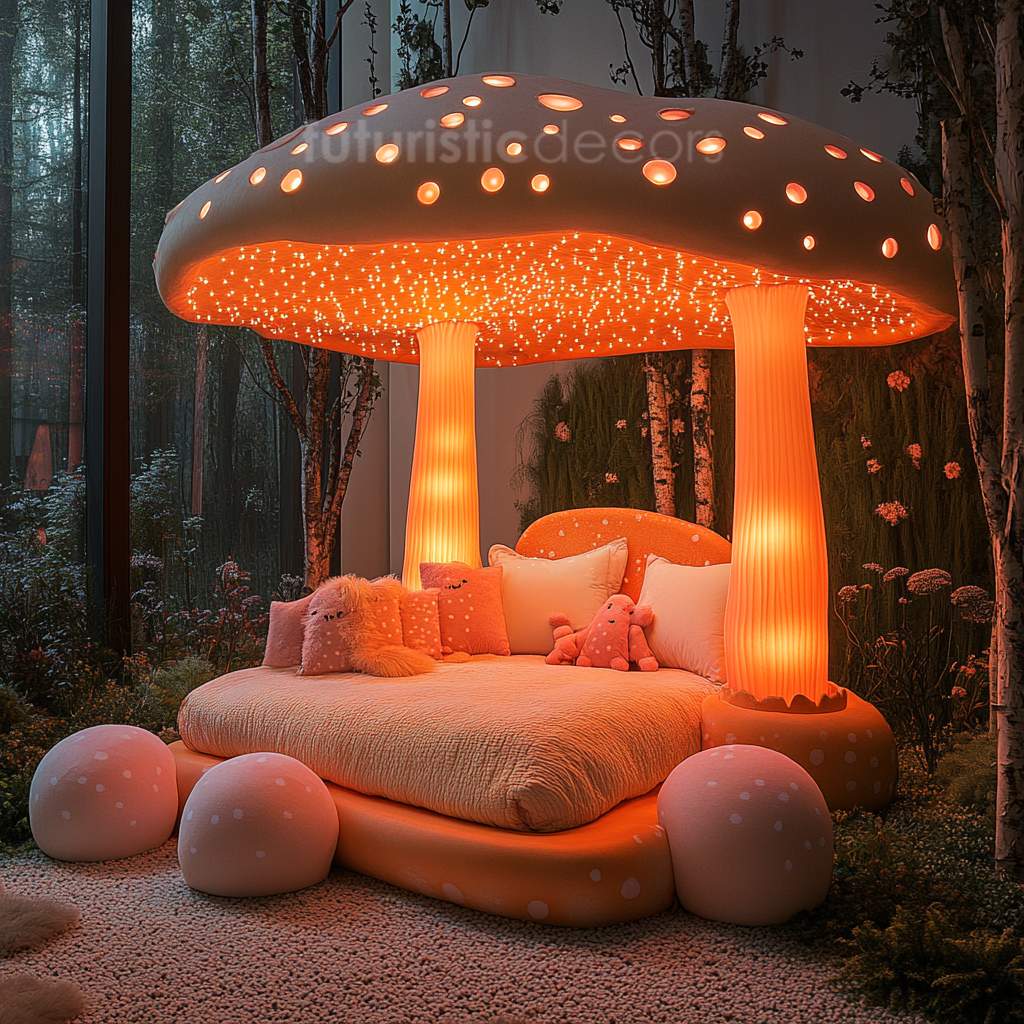
For the glow element, three primary technologies dominate:
- LED Systems: The most versatile, LEDs offer a vast color palette and programmable effects. High-CRI LEDs ensure even light distribution without hot spots, and manufacturers often house them in aluminum heat sinks to prolong lifespan.
- Fiber Optic Bundles: These use a remote LED source to channel light through hundreds of fine strands, creating a smooth, starry-light effect. Fiber optics excel in creating soft gradients and can be woven into upholstery or panel edges.
- Glow-in-the-Dark Pigments: Mixed into paints or embedded in plastics, these pigments charge under ambient light and emit a greenish glow once the lights go out. While cost-effective, they fade over the night and offer limited color choices.
Mattresses and upholstery also factor into the final product. Memory foam or hybrid coil mattresses maximize comfort, while breathable, hypoallergenic fabrics cover the frame. Many brands offer removable, machine-washable covers in plush velvets, faux furs, or durable canvas, ensuring both luxury and practicality.
Understanding these material options empowers you to balance initial cost, energy consumption, maintenance, and visual effect. Whether you prioritize dynamic color changes or prefer a passive, pigment-based glow, there’s a Glowing Mushroom Bed configuration to meet your needs.
5. DIY vs. Pre-made: Crafting Your Own Luminous Bed
For hands-on enthusiasts, building a custom Glowing Mushroom Bed can be a rewarding project. A typical DIY approach involves:
- Frame Construction: Use CNC-cut plywood or metal tubing to shape a stalk and cap. Templates are available online for toadstool profiles.
- Lighting Installation: Choose an LED strip kit or fiber-optic bundle. Affix LEDs under the cap’s edge or weave fibers through drilled holes to mimic gills.
- Diffusion Layer: Cover light sources with frosted acrylic or frosted vinyl film to soften glare.
- Upholstery: Wrap the frame in foam padding and cover with fabric. Ensure cutouts for control panels or charging ports remain accessible.
- Control Setup: Integrate an Arduino or off-the-shelf controller for color-cycling, dimming, or syncing with music.

DIY projects allow full customization—size, color schemes, and control interfaces—often at a fraction of retail prices. However, they require woodworking or metalworking skills, electrical know-how, and time investment. Mistakes in wiring or structural integrity can compromise safety.
Pre-made options, on the other hand, come from specialized manufacturers who ensure UL-certified wiring, structural testing, and warranty support. They range from boutique artisans crafting each bed by hand to larger firms offering modular kits that snap together with minimal tools.
When deciding, weigh your budget, skill level, and desired finish. If you relish creative challenges and have workshop access, a DIY project can yield a one-of-a-kind centerpiece. If you prefer plug-and-play convenience with safety assurances, a professionally manufactured Glowing Mushroom Bed is the smarter choice.
6. Crafting a Cozy Canopy: Integrating Your Glowing Mushroom Bed
Once you’ve selected or built your luminous mushroom bed, the next step is integration into your bedroom layout. Start by considering the bed’s scale: oversized toadstool canopies can dominate small rooms, so position them against a clear wall or in a corner to maximize floor space. For platform designs with inset lights, place the headboard where it can project glow onto adjacent walls, creating ambient washes of color.
Pair your Glowing Mushroom Bed with complementary furniture—think curvy silhouettes and natural materials. A driftwood side table, organic-shaped rug, and faux-leaf wallpaper can reinforce the forest motif. Alternatively, contrast the softness of the glow with industrial elements like metal shelving or concrete planters to achieve a modern twist on the fairyland theme.
Consider canopy extensions: sheer fabric draped from the mushroom cap enhances the cocooning effect while allowing the glow to filter through. Fairy lights woven into the drapes add a twinkling overlay. For children’s rooms, install a low platform skirt around the base, creating a hideaway beneath the bed—perfect for play or storage.
Don’t overlook flooring choices. Light-grey laminate or pale hardwood mimic mossy forest floors, while deep-green carpeting adds an immersive undergrowth feel. Area rugs with mushroom or toadstool patterns tie the theme together.
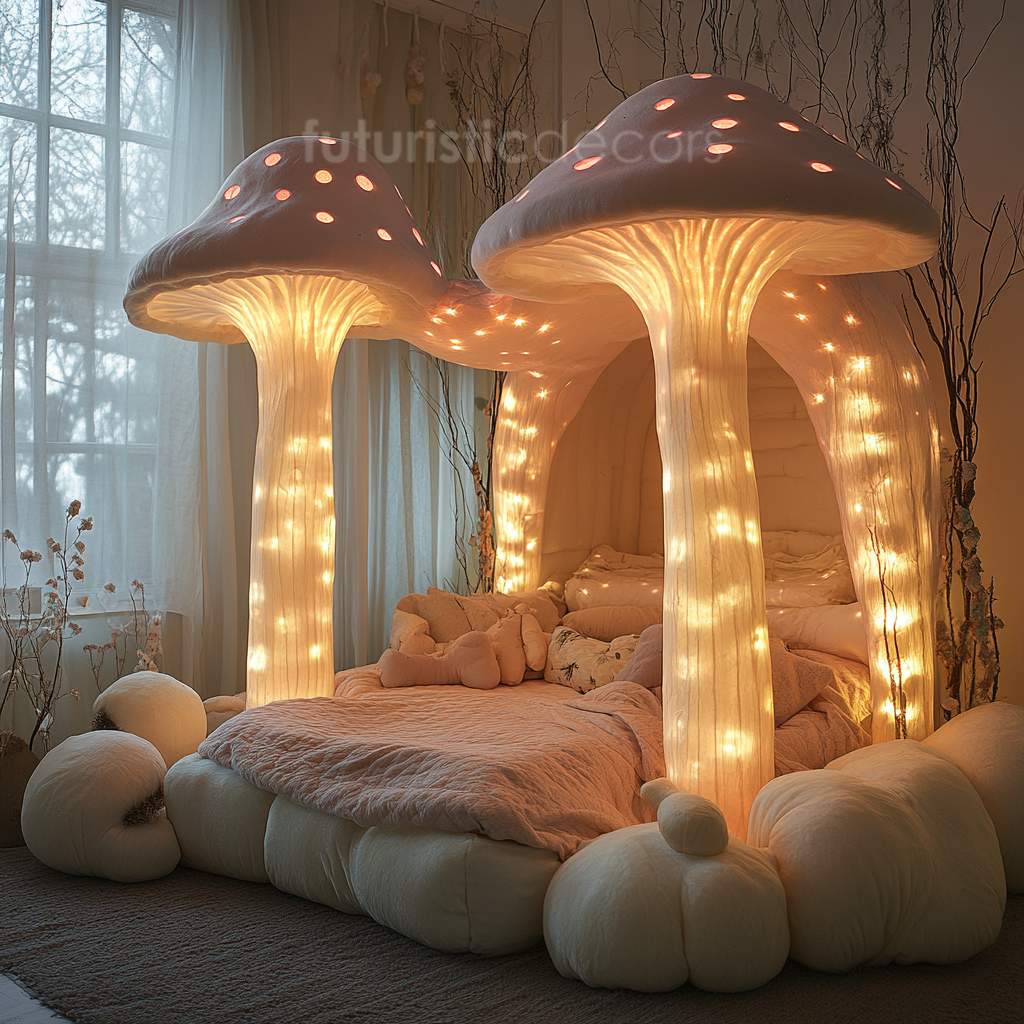
By strategically placing accent pieces—mushroom-shaped lamps, fern-leaf pillows, or bioluminescent-patterned artwork—you’ll elevate the Glowing Mushroom Bed from a standalone piece to the heart of a cohesive fairyland retreat.
7. Setting the Mood: Lighting, Color Schemes, and Textures
A successful fairyland bedroom hinges on more than just a luminous bed—it’s about crafting an immersive environment. Begin with a color palette inspired by woodland scenes: soft greens, muted browns, subtle purples, and creams. Paint walls in matte finishes to absorb excess light, preventing harsh reflections and making the glow appear more pronounced.
Layer lighting: overhead fixtures provide general illumination, while hidden LED strips behind wall moldings or under shelves add depth. Use dimmers throughout to ensure you can dial down to a gentle glow at bedtime. Integrate smart bulbs that shift color temperature—from warm ambers to cool blues—synchronized with your Glowing Mushroom Bed for holistic ambiance control.
Textures also play a key role. Plush velvets and faux furs evoke moss and lichen, while wood and rattan accents reference tree bark and twigs. Incorporate hanging macramé and woven textile wall art to introduce organic patterns. Mirrors with irregular, rounded frames scatter and amplify the bed’s glow, making the room feel larger.
Finishing touches—like scented candles conjuring pine or wildflower fragrances—engage the senses beyond sight. A small tabletop fountain adds gentle water sounds, completing the forest illusion. Through careful layering of light, color, texture, and sound, your bedroom transforms into a multisensory fairyland centered around your Glowing Mushroom Bed.
8. Comfort and Wellness: Sleep Quality and Mindfulness Benefits
While aesthetics drive the allure of Glowing Mushroom Beds, their design also supports healthier sleep and mindfulness practices. Research indicates that exposure to soft, warm light in the evening—rather than harsh, blue-toned LEDs—promotes melatonin production, helping you drift into restorative sleep more easily. Many mushroom bed systems allow you to program sunset-mimicking color fades, gently lulling you toward slumber.
The immersive fairyland environment encourages relaxation rituals. Reading, meditation, or gentle stretching in a softly lit space helps signal to your body that it’s time to unwind. For children, the glow serves as a comforting night light, reducing fear of the dark and supporting independent sleep habits.
Additionally, the organic forms of mushroom canopies and curved headboards have psychological benefits. Studies in biophilic design show that incorporating natural shapes and materials can reduce stress and boost mood. Resting beneath a toadstool-inspired canopy mimics the feeling of being sheltered by tree branches, evoking safety and tranquility.
Pairing your Glowing Mushroom Bed with supportive sleep surfaces—memory foam mattresses or hybrid coils—ensures physical comfort. Add breathable, organic cotton or bamboo linens to regulate temperature. Together, these elements create a holistic sleep sanctuary that nurtures both body and mind.
9. Safety and Maintenance: Keeping the Magic Alive
Maintaining your Glowing Mushroom Bed requires attention to both safety and performance. Always verify that electrical components are UL or CE certified, especially for wiring and controllers housed within the frame. Routinely inspect cables for wear, and replace any LED strips or power adapters showing signs of damage.
Dust and debris can diminish light output. Clean acrylic diffusion panels with a soft microfiber cloth and mild, non-abrasive cleaner. Vacuum fabric covers to prevent buildup, and launder removable upholstery per manufacturer instructions. For fiber-optic systems, ensure light engine vents remain unobstructed to avoid overheating.
If using glow-in-the-dark pigments, periodically recharge surfaces under bright ambient light to restore luminosity. Over time, pigments may degrade; consider reapplying fresh glow paint or swapping to LED inserts for a longer lifespan.
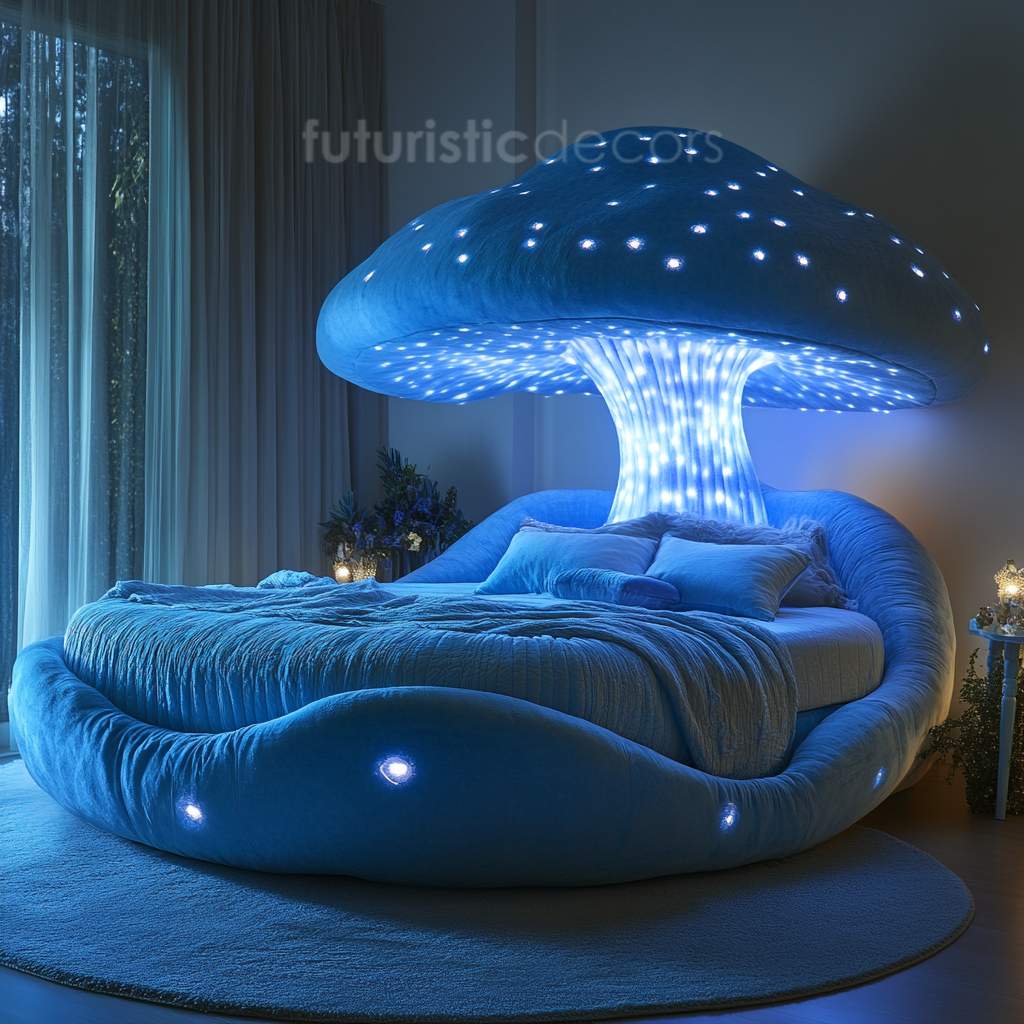
Always secure large canopy structures to wall anchors or ceiling mounts to prevent tipping. When moving the bed, disconnect power and handle with care to protect delicate light elements. By following these safety and maintenance protocols, you’ll preserve the enchanting glow and structural integrity of your Glowing Mushroom Bed for years to come.
10. Sustainability and Eco-Friendly Materials: Glowing Mushroom Beds
As awareness of environmental impact grows, so does demand for eco-friendly Glowing Mushroom Beds. Seek manufacturers using sustainably sourced woods—such as FSC-certified plywood—or recycled metals for frames. Low-VOC finishes and water-based paints minimize indoor air pollution, crucial for a healthy sleep environment.
Energy consumption is another consideration. High-efficiency LEDs consume mere watts, but look for ENERGY STAR–rated systems or solar-rechargeable setups for off-grid installations. Some innovative brands integrate small solar panels into headboard designs, allowing daytime charging of glow panels and reducing reliance on mains electricity.
Recyclable upholstery fabrics—like organic cotton, hemp blends, or recycled polyester—offer durability without polyester waste. Modular designs that allow you to replace individual components (LED strips, canopy fabrics, or support braces) extend the bed’s usable life, reducing landfill contributions.
Before purchasing, review brand sustainability reports or third-party certifications. Choosing an eco-conscious Glowing Mushroom Bed ensures your fairyland retreat aligns with broader environmental values, letting you rest easy knowing your bedroom haven is as green as the forest it evokes.
11. Where to Buy and Price Guide: Glowing Mushroom Beds
Glowing Mushroom Beds range widely in price, depending on size, materials, and technology:
- Entry-Level Kits ($300–$800): DIY kits include basic LED strips, mounting hardware, and a simple canopy frame. Ideal for crafty homeowners comfortable with assembly.
- Mid-Range Pre-Made Beds ($1,200–$2,500): Factory-built platforms with integrated LEDs, fiber optics, and standardized controls. Often include mattress and removable cover.
- Tier-One Luxury Models ($3,000+): Custom designs crafted by boutique artisans. Features programmable multi-zone lighting, premium mattresses, bespoke upholstery, and smart home integration.
Links to purchase similar products: Click here
Key retailers and artisans include:
- FungiGlow Designs: Specializes in toadstool canopies with hand-painted finishes.
- LumiFungi Studios: Offers modular LED-infused beds with app control.
- FairyNest Furnishings: Focuses on sustainable materials and solar-powered glow systems.
When budgeting, factor in ongoing costs: replacement LEDs (~$20–$50 per strip), electricity (negligible for energy-efficient systems), and potential upholstery maintenance. Check for warranties covering electrical components (ideally 2–5 years) and frame integrity.
Exploring second-hand options via maker communities can yield cost savings, but verify condition before purchase. Some owners upgrade glow technology and resell older frames at reduced prices—an eco-friendly way to join the glowing mushroom movement.
Conclusion: Glowing Mushroom Beds
Glowing Mushroom Beds offer a unique intersection of fantasy, technology, and design, turning ordinary bedrooms into mesmerizing fairyland retreats. From the science of bioluminescence to the artful curves of toadstool canopies, each element works in concert to enchant and soothe. Whether you choose a DIY approach or invest in a luxury model, integrating natural textures, smart lighting, and eco-friendly materials ensures a harmonious, sustainable haven.
As a statement piece, a Glowing Mushroom Bed transcends mere furniture—it becomes a nightly portal to wonder, inviting restful sleep and mindful relaxation. Embrace the magic, customize your space, and let each evening under your luminous canopy transport you to an enchanted forest where dreams come alive.



